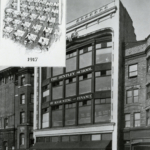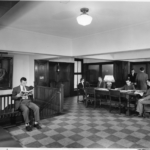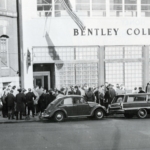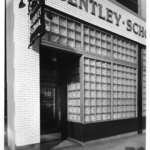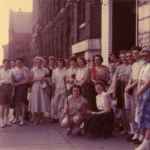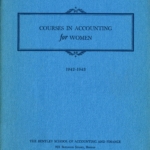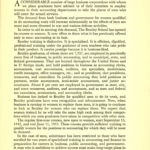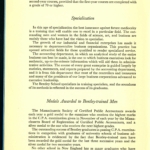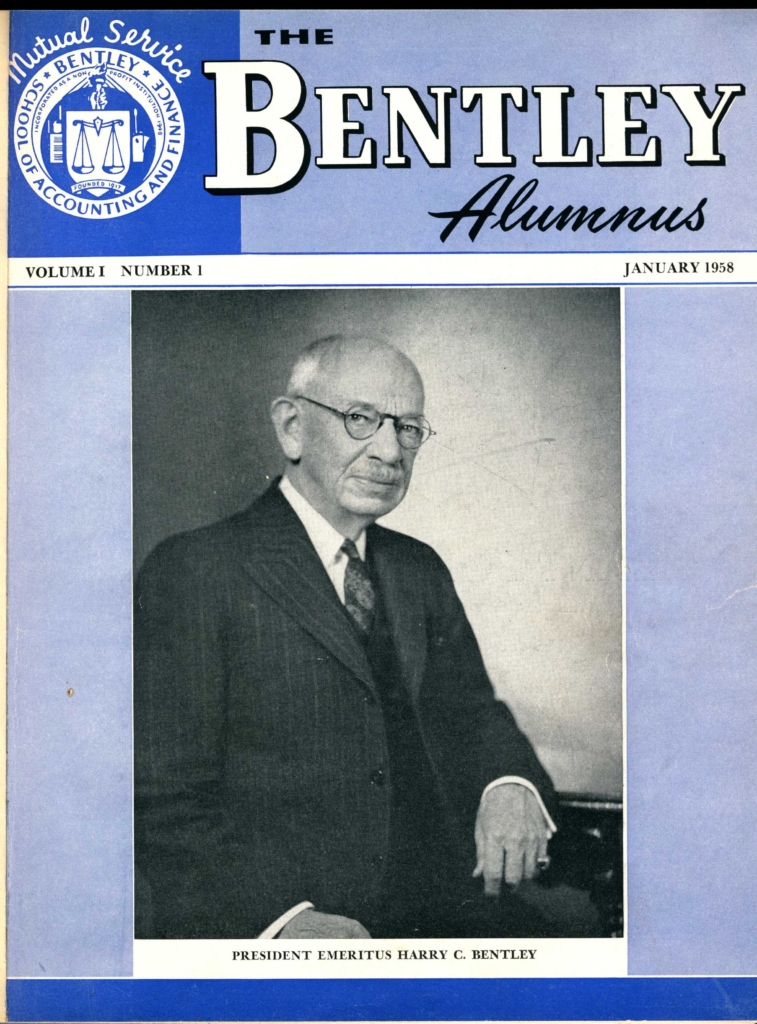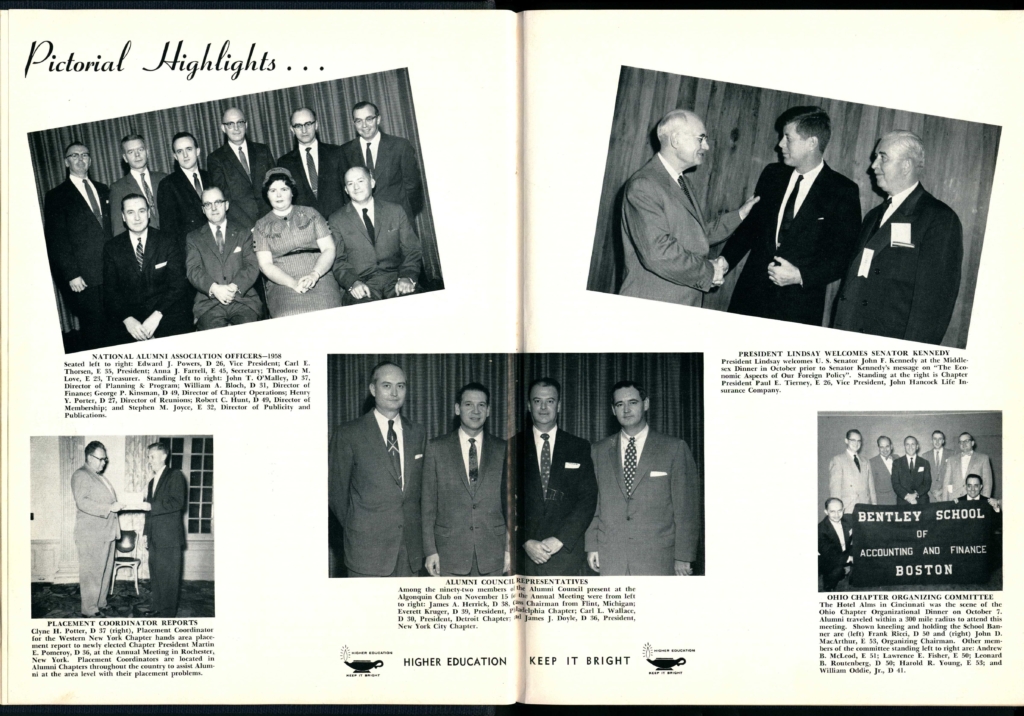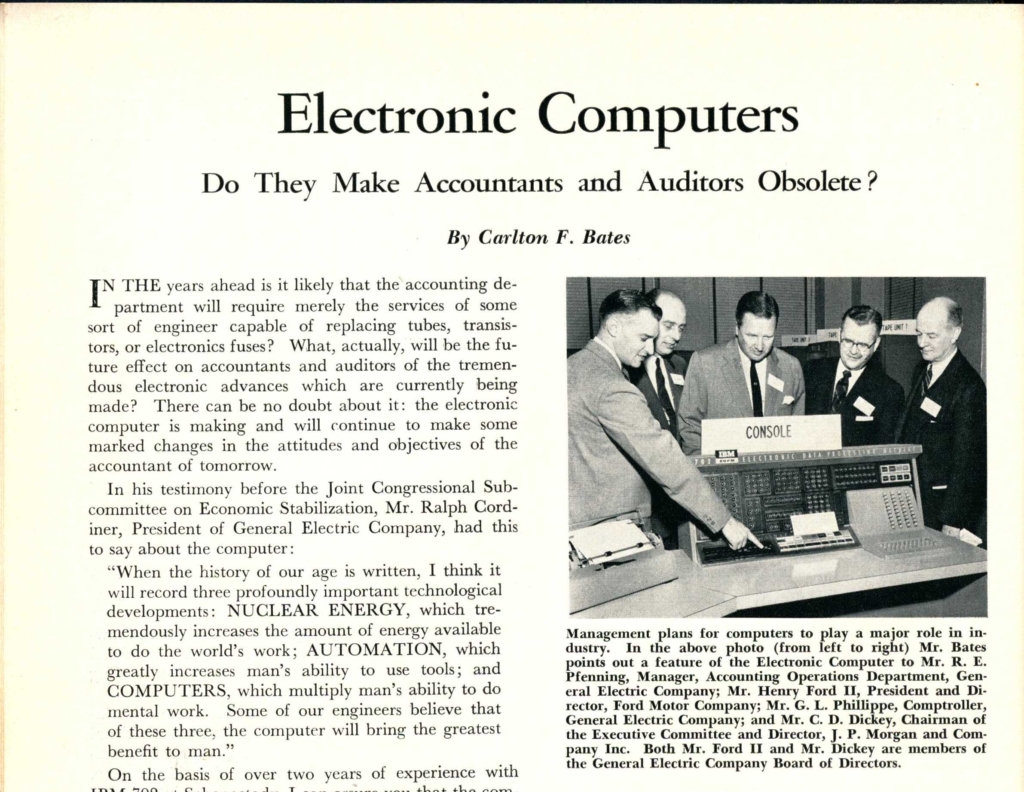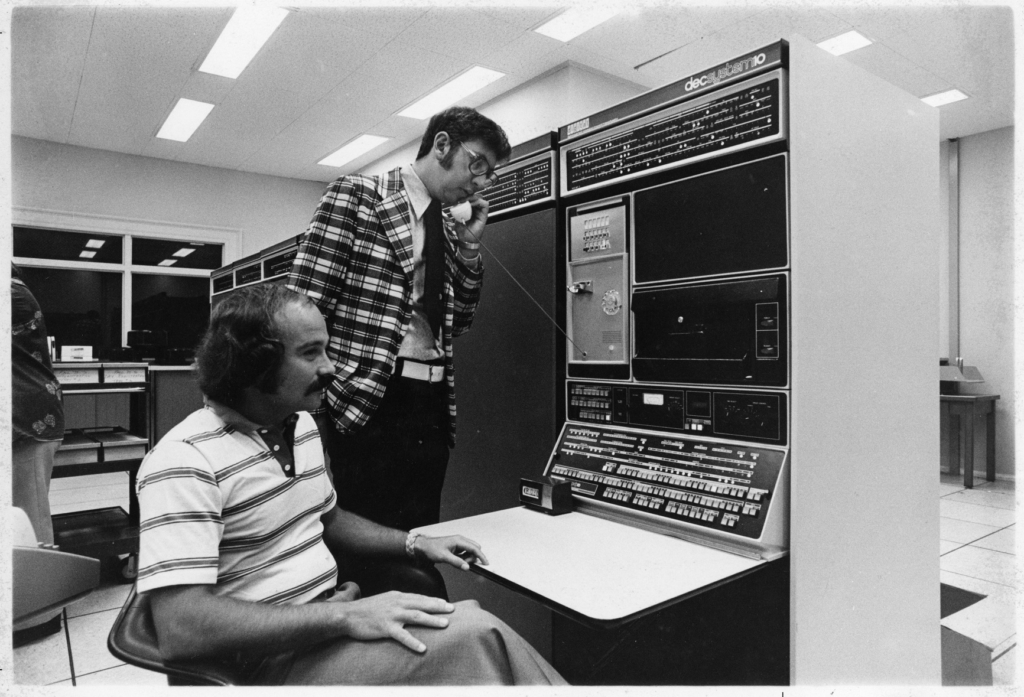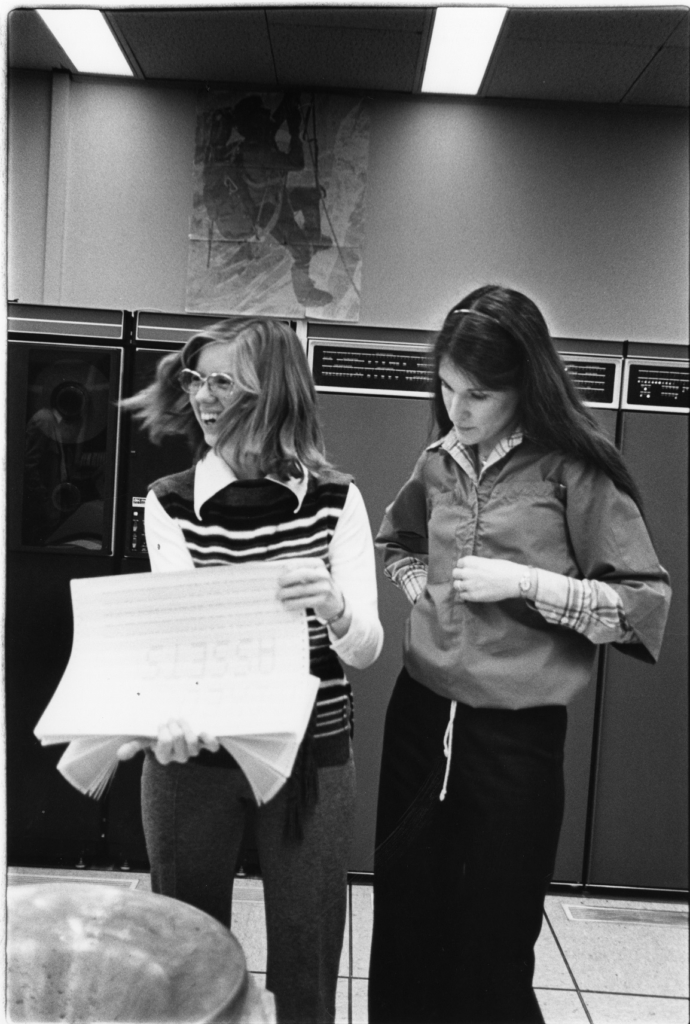Throughout 100 years of history, we have transformed from the Bentley School of Accounting and Finance to Bentley University. Scroll through this exhibit to learn more about how we got to where we are today!
1917: Humble Beginnings
In late 1916, Harry C. Bentley left his position as a professor at the College of Business Administration of Boston University. In early 1917, a group of his former students contacted Mr. Bentley, asking if there was a way that they might continue to study accounting under his instruction.
Mr. Bentley began seeking out a suitable meeting space, and soon secured a room (Bentley’s first “campus”!) at 30 Huntington Avenue in downtown Boston.
Thirty students, soon to be known as The Bentley Associates, attended Mr. Bentley’s first class on February 26th, 1917. Thus, the “Bentley School of Accounting and Finance” was born.
1918-1919: Women attend
Business was a traditionally male-dominated profession during the early years of the Bentley School. However, the continuation of World War I meant that more women were seeking higher education and profitable professional jobs. During the 1918-1919 school year, the Bentley School admitted 162 women to its classes. After the end of the war, however, most women left the school.
Three of the first female students stayed on to graduate. Their names were
Mary R. Gallagher,
Josephine M. Mahoney, and
Frances Sargent.
The latter two are listed here in the program for the 3rd Commencement in 1922.
The excerpt below, from the 1918-1919 Course Catalog, details the women’s course offerings, which at the time were conducted separately from the men’s. It reads,
“If [women] succeed in doing this, and there is no reason why they should not, they will establish for themselves a permanent place in a business vocation that offers excellent opportunities.”
1920: 921 Boylston Street
The building at 921 Boylston Street in downtown Boston is probably the one most associated with the early years of Bentley. For the 1920-1921 school year, Mr. Bentley leased and had renovated several floors of the building to accomodate the expanding student population. While the school held classes or maintained offices in other buildings, 921 Boylston became the heart of “campus”. For several years, 921 Boylston was the sole building that contained all of Bentley’s operations!
1922-1926: Greek Life
Throughout the 1920s, classes at Bentley continued to grow and students started to develop an identity for the school. With this came the emergence of fraternities and (eventually) sororities – typically referred to as campus “Greek life.”
1930’s: Bentley Business
It was also during this decade that Mr. Bentley undertook his major bibliographic project. The result of the project was the two volume “Bibliography of Works on Accounting by American Authors,” still one of the best known among his many publications. To assist in this major undertaking Mr. Bentley hired Ruth S. Leonard, his eventual co-author. Leonard was a trained librarian and conducted years of research to identify the works that would eventually comprise the bibliography. After the culmination of the project in 1935, Leonard remained at Bentley in an administrative capacity for two years, before leaving for an eventual professorship at the Simmons College library school.
1939-1945: War’s Effects
Despite remaining relatively well-attended through the worst of the Great Depression, the onset of World War II left the Bentley School, and many others, in a precarious position.
In less than a decade, enrollment went from an all-time high of 3,084 students in 1938-39, to just 1,055 in 1944-45. Students who enlisted or were drafted to the military sometimes re-enrolled at Bentley after their service. Others were killed in active duty or chose different paths when they returned home.
1942: More Milestones
1942, despite being the mid-point of the World War II conflict, was also a momentous year for Bentley. The School celebrated its 25th anniversary even as it struggled to remain afloat with so few young men able to commit themselves to education.
The 25th Anniversary was a welcome opportunity for those in the Bentley community to have something to celebrate amidst the difficulties of war time.
1942 also stood out as the year that women returned to Bentley. Although women who attended during World War I had been allowed to complete their course, no new women were enrolled during the interwar period.
Between the return of female enrollment in July 1942, through the first post-war school year in 1946, just over 1,000 women took classes at the Bentley School. They made up a large majority of the student population during those years, and are often credited with keeping the school afloat.
Female students did not only support the college financially, but enriched it academically. The benefits of a co-educational school became obvious, and after the end of World War II, admission was permanently granted to female students. Bentley has remained co-educational ever since.
1948: Future Planning
In July 1948, the Bentley School of Accounting and Finance was incorporated as a non-profit organization. While this information might not have made a significant impact on students’ daily lives, it was an incredibly important step for the school.
Mr. Bentley donated his interests in the previous “corporation” of the Bentley School, entrusting the management of the new non-profit to a 27-member Board of Trustees. This development paved the way for Bentley to eventually establish itself as an accredited college.
All 27 original trustees were alums of the Bentley School – with the exception of Mr. Bentley, for obvious reasons! Some familiar names were on the first list of trustees, including Maurice Lindsay, Thomas Morison, and Henry Rauch.
1953: President Lindsay
In addition to his work as a teacher, Maurice Lindsay navigated the school through another enrollment dip during the Korean War, and laid much of the groundwork for the school’s accreditation and move to Waltham. Lindsay was also known for being a prolific painter in his spare time. Many of his paintings were gifted to the college and are still here today. Others were auctioned, sold, or donated to support the Maurice Lindsay Scholarship Fund.
1958-1960: Books & Pages
By the late 1950s, services and facilities at Bentley were expanding at a rapid pace. While the school had always offered books and research help to its students, 1959 saw the establishment of the first Bentley Library. It’s original location would only be open for a short time, as Bentley would move to Waltham with in a decade. However, thousands of books were acquired for the library in just the first few years under James Boudreau – the library’s original director.
Perhaps influenced by all those new books surrounding them, Bentley’s students began publishing. The Alumni Association, which had been established in 1955, published the first Alumni Magazine in 1958 – although a shorter newsletter had been distributed in previous years.
In 1960 the first student newspaper – The Bentley Journal – was also published. Although the newspaper has changed names many (many!) times in the ensuing decades, it has been a continuous feature at Bentley since its inception.
1961: Bentley College
An additional expansion of degree-granting authority in 1971 occasioned the name to be changed again. It became simply “Bentley College” as the school continued to move towards a more comprehensive, yet business-oriented education.
Mr. Morison received a diploma from the Bentley School in 1938, and returned to teach classes in 1946 at the urging of his good friend Mr. Bentley. Morison was instrumental in the selection and development of the Waltham campus, and he remained involved with Bentley affairs after his retirement.
1962-1968: Welcome to Waltham
By the 1960s Bentley had a new name and an expanded set of educational goals, and it was time to more closely examine the college’s location. Downtown Boston had its conveniences, but the Back Bay area was undergoing a number of major changes – most notably the construction of the Prudential Tower. This meant that it was difficult to find and lease adequate space to house and educate the growing number of students at Bentley.
After a lengthy search process, 103 acres were purchased in Waltham, where the campus still stands today. Construction began in 1965, and students, faculty, and staff all got ready to make the move a few miles away.
The Waltham campus opened in 1968 and has been Bentley’s home base ever since. While several buildings (Smith, for example) were built over the next few decades, a lot of what you see on campus today is a result of the original construction. Take a look at some of the photos to see how the original campus came to be.
1970-1971: Rapid Expansion
After seeing the school through its historic move to Waltham, President Morison made the decision to retire. In 1970, the college chose Gregory H. Adamian as its 4th President. Mr. Adamian had begun teaching at Bentley in 1955 after receiving his law degree from Boston University. He practiced law both before and during his professorship at Bentley, and was chair of the Law department at the school before his presidency. Mr. Adamian would go on to serve as President for 21 years, retiring in 1991 and seeing the college through a number of significant developments.
One of the first changes to occur under President Adamian was in the degree courses offered. In 1971 Bentley was authorized to grant Bachelor of Arts degrees, honorary degrees, and an expanded slate of Bachelor of Science degrees in business disciplines. With this came another name change, and the Bentley College of Accounting and Finance became, simply, Bentley College. And with that came some much more succinct signage, which you can see in the photo above!
1973: Graduate School
With a good sense of momentum and a lot of hard work on the part of students, faculty, and staff, Bentley grew once again in 1973.
The Graduate School, later known as the McCallum Graduate School of Business, opened its doors with 186 students and initial degrees of Master of Science in Accountancy and Master of Science in Taxation.
Today the Graduate School has over 1,000 students, thousands of alumni, and greatly expanded offerings for both MS and MBA programs. The school is named for Elkin B. McCallum, a 1967 Bentley graduate and former trustee of the college.
1976: Business Ethics
With the larger campus and new course offerings came an opportunity for Bentley to consider how it could expand its impact on the world of business education.
The result of these considerations was the Center for Business Ethics, opened in 1976 and still a huge part of Bentley’s culture today. The Center was founded by Professor W. Michael Hoffman, who still serves as Executive Director as the CBE approaches its 40th anniversary.
The CBE was developed to ensure that Bentley students learned the value of corporate responsibility and thoughtful leadership before they became members of the working world. It offers a lending library of business ethics publications, and manages executive education and fellowships, as well as the Raytheon and Verizon Lectureships.
1980: Rauch Honored
It was not until 1980 that Bentley decided to use its degree-conferring authority to bestow an honorary degree. Henry E. Rauch was overwhelmingly chocen as the first recipient, thanks to his significant leadership over the years at Bentley. Rauch, an alum from the evening class of 1924, was a close friend of Mr. Bentley and a founding member of the Board of Trustees. He would eventually serve as Chairman of the Board from 1970-1978.
He was presented with an Honorary Doctor of Laws Degree at the 1980 commencement ceremony. The photo above shows Hugh Dysart Jr., who was Chairman of the Board at the time, and President Adamian presenting Rauch with his degree.
Mr. Rauch had a long-standing history of contributing to Bentley when he made this historic donation in 1984. Some of his previous donations had helped the college’s relocation efforts, and established a fund to provide faculty with research opportunities. This donation helped to support the Bentley Challenge campaign which was running at the time to finance the expansion of campus facilities and technology.
1984: Computer Fluency
Throughout the early part of the 1980s, class offerings in computer systems expanded, and general computing resources on campus grew. However, Bentley leaders also wanted to ensure that students would become, in the words of President Adamian “computer fluen[t]” as opposed to simply “computer litera[te].”
At the beginning of the 1984-1985 school year, 115 first-year students were given “portable micro-computers” to use in selected Accounting, English, and Computer Information Systems classes. This was called the “Computer Information Systems pilot program.”
By the next year, portable micro-computers were distributed to all incoming students on campus. The size and specs might be different, but this is the same program that Bentley students benefit from now when they receive their laptops upon arrival!
1980s: Building Boom
Although the core of Bentley’s Waltham campus opened in 1968, the college continued to periodically add and/or renovate property to increase the number of services it could offer and the number of students it could house.
The 1970s saw some impressive expansion, most notably the Dana Center which originally opened in 1973.
The 1980s, however, were sometimes referred to in the student newspaper as Bentley’s “Building Boom” – yet another significant expansion when a lot of the modern footprint of campus came into existence.
Just some of the projects of the 1980s are highlighted in these photos.
- Collins Hall – then known as Brook Hall – opened in 1980, and around 1985 got a renovation that included the hundreds of dorm rooms now contained within.
- A formal President’s House was planned early in the 1980s and opened in 1983.
- Also opened in 1983 – the Adamian Academic Center, which was called the Graduate Center until President Adamian’s retirement in 1991.
- The Falcone Apartments opened in 1985.
- The Rauch Administration Center, dedicated to original Trustee Henry E. Rauch, opened in 1986.
- Cape House, also known as “The Cape” opened in 1986 as well.
- The Orchard Apartments (North & South) opened in 1988.
As if that wasn’t enough, the Dana Center got a new pool, and the Lower Caf got a renovation!
1991: An Era Ends
After two decades of guiding Bentley through a period of historic growth, President Adamian retired in 1991. However, after Mr. Adamian’s departure the college was left in the capable hands of Joseph M. Cronin, who was selected to be Bentley’s 5th President. As you can see from this photo, taken in 1973, he was already a familiar face on campus! Mr. Cronin came to Bentley from the field of educational administration, and brought a keen eye for productive, forward-thinking policies. During his years at Bentley, the college launched the Service-Learning Program and opened the Trading Room – two initiatives that continue to make Bentley special and improve opportunities for students and the larger community.
1997-2002: Growth & Change
In 1997 the college welcomed its 6th President, Joseph G. Morone. Mr. Morone came to Bentley with a background in political science and technological policy, and he focused his efforts on integrating technology fully into life and work at Bentley. In addition, Mr. Morone also led the college through acquisition of more property, which it would soon use to make Bentley living even more comprehensive.
The sprawling athletic fields now visible from Forest Street on your way in and out of campus were acquired in 1999. The 33 acres formerly served as the DeVincent Farm.
With the space regained from the former site of athletic fields, the college got underway building what are now the Copley North & South apartments, which opened in 2001.
In keeping with President Morone’s aim to increase the ubiquity of technology on campus, the Smith Academic Technology Center opened in 2000.
The Student Center, which has recently benefited from a major renovation, originally opened in 2002.
2001: A Community Pauses
Just as a new school year was beginning, the Bentley community was shaken by the attacks of September 11th, 2001.
The response on campus was swift and supportive, with many students, faculty and staff gathering that very afternoon to comfort each other and share information.
Within a few days, grief counseling and a blood drive had been organized, and several faculty members held a forum to discuss the attacks and their impact in order to help students feel informed and regain a sense of safety.
Unfortunately, the Bentley community was not immune from suffering personal losses as a result of 9/11. Four alumni were killed that day, along with others who were family members or friends of Bentley community members.
A formal memorial was held for the lost alumni, listed below, which included a candle-lighting ceremony and a release of butterflies.
David G. Carlone, Class of 1977.
Amy E. Toyen, Class of 1999.
Terrence D. Gazzani, Class of 2000.
Peter O’Neill Jr., Class of 2001.
2005-2007: New Faces
In 2005 the college welcomed a crop of new students to campus with the addition of PhD programs in Business and Accountancy. This expansion supported Bentley’s long-time commitment to producing thoughtful leaders and has seen great success in the past decade.
2005 also saw the departure of President Morone. After a comprehensive search, the college selected Gloria Cordes Larson who, since 2007, has served as Bentley’s 7th President. Larson came to Bentley with a degree in law and a background in both law and economic policy. The fusing of distinct educational enclaves was very important to her, and she has dedicated much of her work at Bentley to making sure that students continue to get as well-developed and comprehensive an education as possible.
2008: Bentley University
Effective October 2nd, 2008, Bentley College became Bentley University – by the authority of the Commonwealth of Massachusetts.
Years of work had been building towards this distinction. The PhD programs and the further integration of liberal arts into the business facets of the undergraduate program were two of the main milestones.
The school’s physical expansion, and the introduction of the Liberal Studies major in 2005 also contributed to recognition of Bentley’s university-level credentials.
2010-2012: MBA Programs
Between 2010-2012, Bentley’s offerings for the Master of Business Administration degree went through a period of change and development.
Bentley’s current MBA program came about in 2012, after having been paired with other degrees like the Master of Science in Information Technology.
The university currently has offerings including the Emerging Leaders MBA and the Professional MBA.
2013 – : PreparedU
Since late 2013, Bentley has committed to the PreparedU Project, an effort spearheaded by President Larson. The program kicked off with a nationwide survey about millennials entering the workforce. These results, along with additional research, helped PreparedU develop a slate of reports and initiatives designed to help millennials find success in the working world.
The PreparedU initiative also led to the establishment of a recurring on-air segment during Bloomberg Radio’s “Taking Stock” in which issues surrounding education and career development are discussed. PreparedU also collaborates with Bentley’s Center for Women in Business to focus on the particular issues that women face in the corporate environment.

